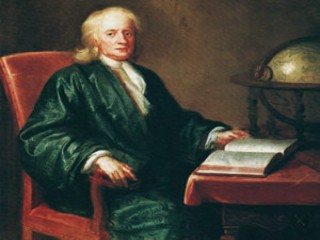
Robert Hooke biography
Date of birth : 1653-07-16
Date of death : 1703-03-03
Birthplace : Freshwater, Isle of Wight, England
Nationality : English
Category : Historian personalities
Last modified : 2011-05-30
Credited as : Scientist, architect and astronomer, wrote Micrographia, Gamma Arietis
6 votes so far
A gifted student with a particular talent for mechanics, Hooke was educated at Oxford, where he assisted Robert Boyle with his successful air pump experiments. A member of the Royal Society from 1663, Hooke was accomplished in astronomy, biology, physics and architecture, and his skill as an instrument maker gave him an edge over his contemporaries. He argued with Isaac Newton over the nature of light and gravity, and their long-running debate is said to have left both men forever bitter toward each other. Hooke's studies of springs and elasticity led to his enunciation of "Hooke's Law" (a spring's extension is proportional to the weight hanging from it), and he is credited with inventing the balance spring that allowed for the making of small, accurate timepieces. He also invented a reflecting microscope, the universal joint, and a variety of clocks, barometers and optical devices. Although not a surveyor or architect by profession, Hooke was named London's Surveyor after the Great Fire of 1666 and, with Christopher Wren, given the task of rebuilding the city.
Hooke achieved fame in his day as Surveyor to the City of London and chief assistant of Christopher Wren. Hooke helped Wren rebuild London after the Great Fire in 1666, and also worked on designing London's Monument to the fire, the Royal Greenwich Observatory, Montagu House in Bloomsbury, and the infamous Bethlem Royal Hospital (which became known as 'Bedlam'). Other buildings designed by Hooke include The Royal College of Physicians (1679), Ragley Hall in Warwickshire, and the parish church at Willen in Milton Keynes, Buckinghamshire. Hooke's collaboration with Christopher Wren also included St Paul's Cathedral, whose dome uses a method of construction conceived by Hooke. Hooke also participated in the design of the Pepys Library, which held the manuscripts of Samuel Pepys's diaries, the most frequently cited eyewitness account of the Great Fire of London.
In the reconstruction after the Great Fire, Hooke proposed redesigning London's streets on a grid pattern with wide boulevards and arteries, a pattern subsequently used in the renovation of Paris, Liverpool, and many American cities. This proposal was thwarted by arguments over property rights, as property owners were surreptitiously shifting their boundaries. Hooke was in demand to settle many of these disputes, due to his competence as a surveyor and his tact as an arbitrator.
















